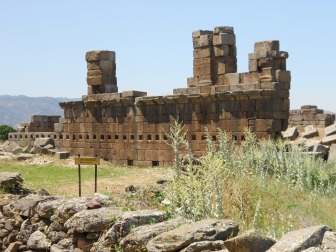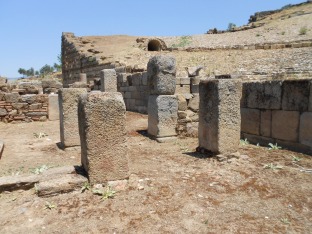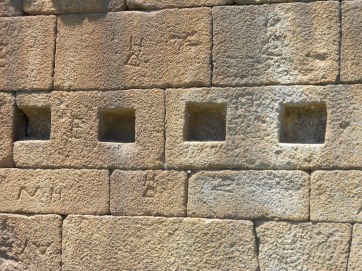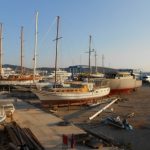The ruins of the ancient Carian settlement of Alabanda lie northeast of Çine along a quiet country road in the Araphısar Mahallesi of Doğanyurt. The village of Araphisar was built right on top of the ruins, and bits of masonry taken from ancient structures can be seen in the walls of newer structures.
A few old stone houses still survive, mostly in ruins. One is now used as part of the Kazı Evi (Excavations House) by archaeologists from Aydın University, another is preserved in a pretty garden near the temple of Apollo.
Life here proceeds at a very slow pace and revolves almost entirely around agriculture. There are almost no young people left in the village.
Compared with nearby Alında this is an easy site to explore with many of the remains close to the road.
Around the site
In a field east of the road can be seen the substantial standing remains of the Meclis Binası (Council House) whose most mysterious features are the Greek letters carved into the individual blocks of the outside wall. They look like mason’s marks and it’s easy to assume that they were intended to show the sequence in which the stones should be laid. However, some of the letters are upside down and others are out of sequence so their actual purpose remains unknown.
On the other side of the road immediately behind the bus stop there are slight remains of the gateway leading into the old town and stretches of the Byzantine city wall.
Following the path into the village you will see the remains of the temple dedicated to Apollo Isotimus, possibly a conflation of a local deity with Apollo. Nothing now remains of the temple except foundations. During excavations here it appeared that a church was later built on the same site which was in turn covered by a Byzantine tower.
On the opposite side of the path stand battered remnants of an ancient bathhouse.
 If you continue walking up the path through the village you will come eventually to the remains of a theatre in far worse shape than most such structures. The huge free-standing external walls survive well but the tiers of seating have almost entirely disappeared. On the other hand parts of the rooms behind the stage still survive as do the curiously stumpy Doric columns supporting the wings of the building.
If you continue walking up the path through the village you will come eventually to the remains of a theatre in far worse shape than most such structures. The huge free-standing external walls survive well but the tiers of seating have almost entirely disappeared. On the other hand parts of the rooms behind the stage still survive as do the curiously stumpy Doric columns supporting the wings of the building.
Amid the rubble littering the theatre lie the remains of what resembles a sundial like the one at Knidos but in much worse condition.
Above the theatre stands a short stretch of the wall ringing the acropolis. Down a side turning are slight remains of a temple to Zeus Chrysaoreus.
Transport info
Minibuses to Doğanyurt from Çine‘s town-centre otogar pass Araphisar for the ruins at Alabanda. If instead you take a taxi you will be able to continue along this wild, remote road to Karpuzlu for the more dramatic ruins of Alında.
Read more about life here: http://turkeyfromtheinside.com/blogbloggingaboutturkey/entry/80-turkey-s-empty-villages.html
 The curious “mason’s marks” at Alabanda’s Council house
The curious “mason’s marks” at Alabanda’s Council house


